The Easy Way to Eliminate Annoying Houseplant Flies
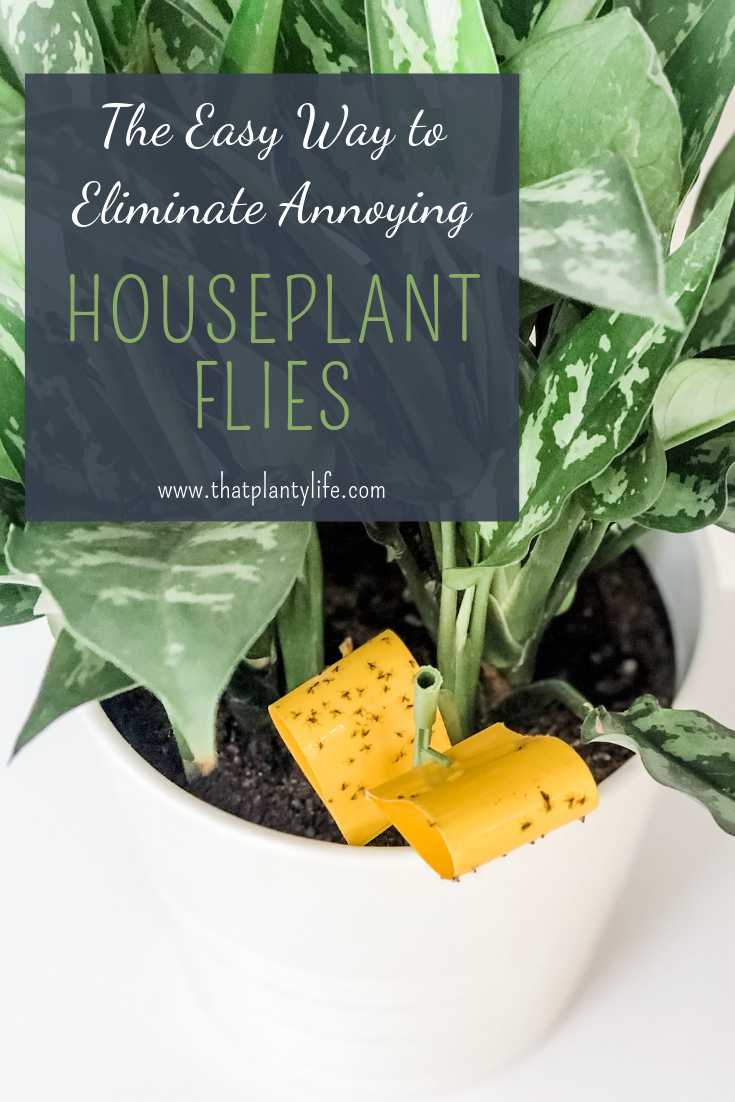
About a month ago I was sitting in my rocking chair holding my baby and admiring my houseplants. As one does when one is a crazy plant lady. The next thing I notice is little tiny flies flying all around my plants and crawling in the soil! Gosh Darn-it!! Some of my plants were infested with fungus gnats! At first, I panicked, but after a few deep breaths and a couple of failed home remedies, I did a little more research and found a super easy solution that worked for my houseplants.
If you have houseplants for a long period of time there is a really good chance that you too will encounter this common pest. Let’s find out what these annoying insects actually are and how to get rid of them!
Fungus Gnats – What exactly are these little annoying flies?
Fungus Gnats are very small black flying insects. They are similar to fruit flies, but are even smaller and are all black. These little bugs are attracted to decaying material found in houseplant soil. Always be on the lookout for these little buggers so you can act fast before any real damage is done. A trick to finding them is when you water your plants you’ll notice them fly up off the soil.
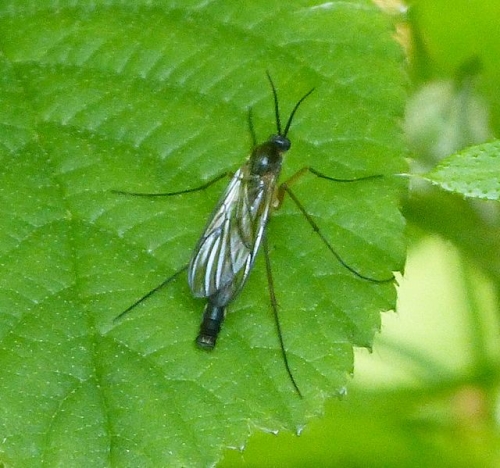
While the actual insect can be quite harmless, besides being extremely annoying to me, the real destruction comes from their babies. The fungus gnat has a short life of about 7-10 days but in that amount of time a female can lay up to 300 eggs in the soil of your precious houseplant.
The larvae of the fungus gnat are the real problem. Once they hatch they start to feast on the delicate roots of a houseplant. This can be extremely detrimental to baby plants and houseplant cuttings. Left unchecked they can destroy the roots of a plant, which will lead to the tragic death of your planty friend.
Where do they come from?
There are many different reasons why fungus gnats could be a problem you encounter.
- They are very tiny and can fly into your home through open doors and windows. They can even squeeze through screens.
- You could purchase a plant that is already infested and bring it into your home.
- I recently received a gift basket of houseplants and sadly those plants were infested with fungus gnats.
- The soil you used to plant your houseplant may already be infested.
- If you let your plant enjoy some time outside on a nice summer day it might come back into your house with some unwelcome friends.
Once they make it inside they will be attracted to the moist soil of houseplants and make themselves nice and comfortable in their new home.
How to get rid of them!
Finding the offender
The first step is to figure out which plants infected. It’s always a good idea to be routinely checking your houseplants for signs of disease or pests. I like to examine each plant when I water them. As I did a little investigation into my pest problem I found the offender. A pothos plant I received in a gift basket was completely infested with gnats. Luckily a pothos plant is pretty resilient and can survive a lot. Check out our post on this great plant here.
I quickly took the pothos plant out of its pot and discarded all of the excess soil I could get off. I repotted it with some new fresh soil and started researching how to eliminate the rest of the gnats in my home. Always treat all of the houseplants in your home because you don’t know how many are affected. Even if you don’t see gnats flying around a houseplant, there could be unseen eggs/larvae in the soil.
Finding the Solution
I began my research and tried a couple of different “home remedies” for fungus gnats. But after my 3-year-old knocked over my cup of apple cider vinegar onto my carpet I decided there had to be a better solution. Enter Amazon, the place where you can find anything and everything you need!
After some research, I ordered these Houseplant Sticky Stakes. There are also just plain sticky traps like this. I opted to go with the stakes for two reasons. I thought the stakes were more discreet than the flat trap. Additionally, I have three little ones at home and I just know that those flat traps would have been stuck to little human hands in a matter of minutes.
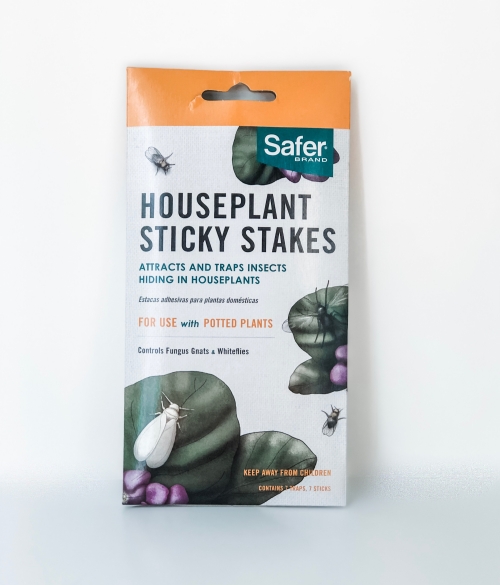
After the long two days wait, they finally arrived. I quickly got them together and set up in my houseplants. One weird thing about this product is that there are not enough sticky traps to fill up all of the stakes. That was a definite con of the product but they worked so well I would definitely reorder if I needed more.
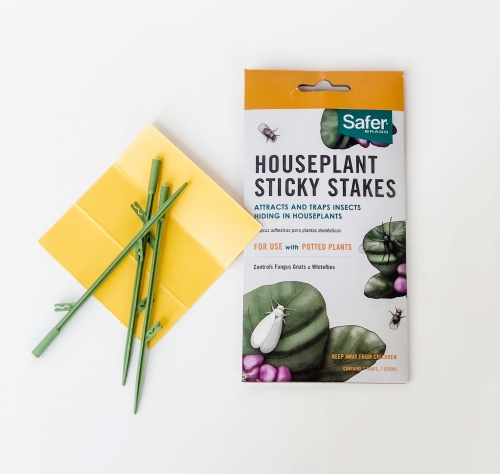
When I first set them up in my houseplant soil I was a little skeptical they would work. I was staring at the traps and staring at the flies and felt annoyed that the flies weren’t immediately flying onto the traps. I tried to be patient and about a week later I couldn’t believe how many little flies were on those traps.
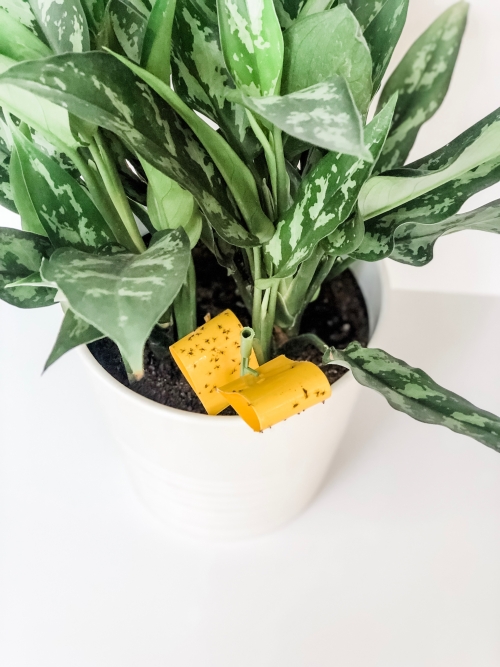
Extra Precaution
I also chose to take an additional step of rinsing out my houseplants with a mixture of hydrogen peroxide and water. Use one part hydrogen peroxide to four parts of water. Drench the soil until it comes out the bottom of the pot. Hydrogen peroxide kills fungus gnat larvae on contact. After about a month of using the sticky traps as well as following through on some other prevention/controlling tips, the fungus gnat population is pretty much extinct.
Prevention Tips
Before you buy
Make sure to use a quality indoor potting soil. Never use outdoor potting soil or reuse old soil from previous plants or outside. While indoor potting soil can still have a chance of being infected with fungus gnats the chances are a lot less.
First and foremost always inspect a potential planty friend before purchasing. If you see any signs of fungus gnats make sure to pass. When you do purchase a new plant you can also keep it separate from the rest of your plants for a week or two to make sure you’re all clear of any potential pests or disease.
Also instead of keeping the soil in the bag it comes in, store it in an airtight container while not in use. Fungus gnats, larvae, and eggs need air to survive so this will help to prevent the soil from getting infested.
Watering Issues
Fungus gnats love a moist environment. The moist, overwatered soil of a houseplant is its perfect home. Watering your houseplants the appropriate amount and letting them dry out in between waterings can really help to decrease the chance of a fungus gnat infestation. Check out this blog post, which gives a great tip on how to not overwater your houseplants.
Another way to keep the top of the soil dry is to bottom water your plants. This will keep the top of the soil dry preventing gnats from wanting to lay eggs there, while still keeping your plants hydrated and happy.
Plant Maintenence
Decaying material attracts fungus gnats to houseplants so be sure to keep your houseplant free of dead leaves and debris.
Adding a layer of horticultural sand or rocks to the top of your houseplant soil can help discourage fungus gnats from laying their eggs in the soil.
With my research, I read a lot of great things about the pest control powers of neem oil. I recently purchased this neem oil to help reduce any chance of future problems.
As you grow your urban jungle you’re going to run into different pests but if you act quickly you can save your plant babies! Drop us a comment below if you have any questions or pest problems we can help you with.
Pin It!
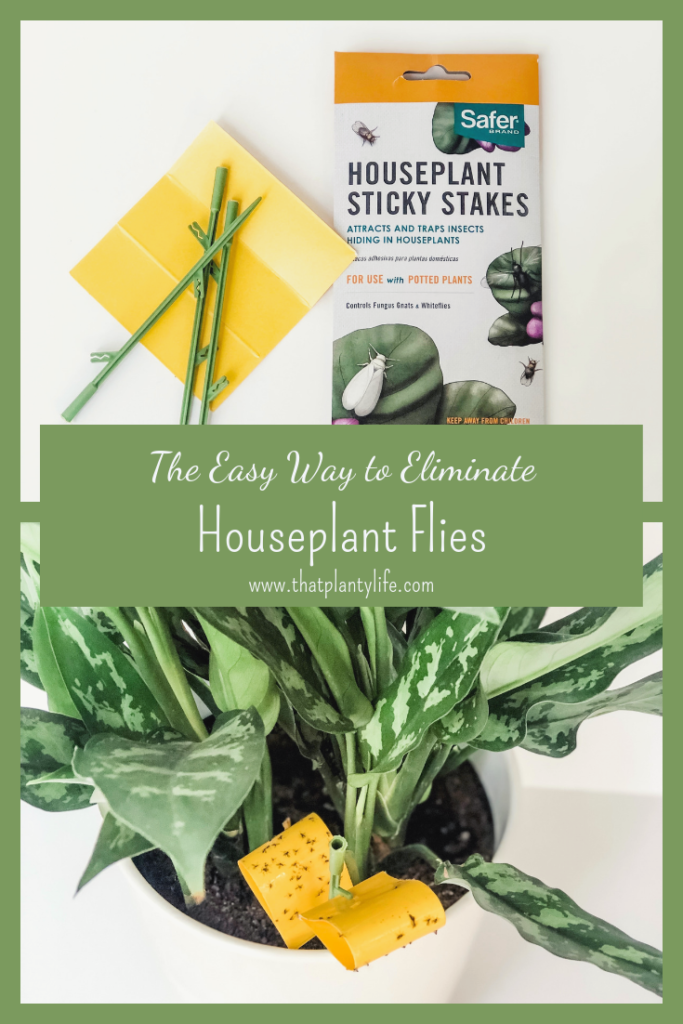




Leave a Reply